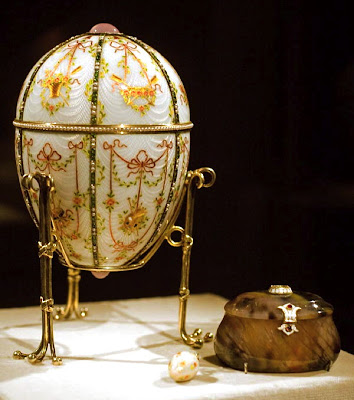This egg is made of translucent opalescent white enamel over a guilloché ground. Gold bands encrusted with demantoid garnets and seed pearls divides the surface into twelve panels. These panels are then decorated with neoclassical flower and bow motifs. In both ends of the egg sits a cabochon stone, surrounded by rose-cut diamonds.
Inside the egg the surprise can be found, lying in a fitted compartment lined with velvet - a miniature bonbonnière box made of agate. On top of the lid sits a rectangular portrait-cut diamond covering the date "1903" in white enamel. The little box is also decorated with cabochon rubies. Inside the bonbonnière another surprise is to be found - a tiny, egg-shaped pendant made of gold and enamel.
If you compare the "Bonbonnière Egg" with the "Gatchina Palace Egg" (above) that Fabergé made for the Imperial Family in 1901, great similarities can be seen. Although the Kelch version is unmarked, Mikhail Perkhin was probably the creator of both of these eggs.
After not being sold when offered by a private US owner at Christie's, New York, in 1990, it was still sold after the auction to an anonymous buyer somewhere in the world...





